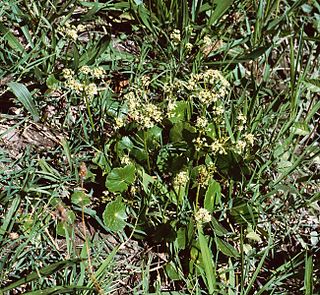
The Araliaceae is a family of flowering plants composed of 55 genera and 1500 species consisting of primarily woody plants and some herbaceous plants. The morphology of Araliaceae varies widely, but it is predominantly distinguishable based on its woody habit, tropical distribution, and the presence of simple umbels.

The term mustard oil is used for two different oils that are made from mustard seeds:

Rudbeckia hirta, commonly called black-eyed Susan, is a North American flowering plant in the sunflower family, native to Eastern and Central North America and naturalized in the Western part of the continent as well as in China. It has now been found in all 10 Canadian Provinces and all 48 of the states in the contiguous United States.

Hydrocotyle, sometimes called water pennywort, Indian pennywort, marsh penny, thick-leaved pennywort and even white rot is a genus of prostrate, perennial aquatic or semi-aquatic plants formerly classified in the family Apiaceae, now in the family Araliaceae.

Clidemia hirta, commonly called soapbush or Koster's curse, is a perennial shrub. It is an invasive plant species in many tropical regions of the world, creating serious damage.

Hydrocotyle ranunculoides, known commonly as floating pennywort, or floating marshpennywort, is an aquatic plant in the family Araliaceae. It is native to North and South America and parts of Africa.

Achille Richard was a French botanist, botanical illustrator and physician. The standard author abbreviation A.Rich. is used to indicate this person as the author when citing a botanical name.

Nikolai Stepánovich Turczanínow was a Russian botanist who first identified several genera, and many species of plants.

Banksia hirta is a species of shrub that is endemic to Western Australia. It has hairy stems, deeply serrated leaves, pale yellow flowers in heads of about one hundred and shining follicles. It is restricted to the Stirling Range National Park.

Hydrocotyle vulgaris, also known as marsh pennywort, common pennywort, water naval, money plant, lucky plant or copper coin, is a small creeping perennial aquatic herb native to N. Africa, Europe, the Caucasus and parts of the Levant.

Senecio crassiflorus, one of the native South American Senecio and an herbaceous dune dwelling perennial.

Hydrocotyle bonariensis, the largeleaf pennywort, once a member of the family Apiaceae, now in the family Araliaceae and of the genus Hydrocotyle is a hairless and creeping perennial.

Hyparrhenia hirta is a species of grass known by the common names common thatching grass and Coolatai grass. It is native to much of Africa and Eurasia, and it is known on other continents as an introduced species. In eastern Australia it is a tenacious noxious weed. In South Africa, where it is native, it is very common and one of the most widely used thatching grasses. It is also used for grazing livestock and weaving mats and baskets.

Euphorbia hirta is a pantropical weed, possibly native to India. It is a hairy herb that grows in open grasslands, roadsides and pathways. It is used in traditional herbal medicine.

Carex hirta, the hairy sedge or hammer sedge, is a species of sedge native across Europe. It has characteristic hairy leaves and inflorescences, and is the type species of the genus Carex.

Hydrocotyle prolifera, commonly called whorled marshpennywort , is a species of flowering plant in the ginseng family (Araliaceae). It is native to North America and South America, where it is widespread. In the United States, it is largely restricted to the southeastern and southwestern regions. Its natural habitat is in swamp forests, or in pools of standing water.

Hydrocotyle sibthorpioides is a small plant native to southeastern Asia. It is also referred to as lawn marshpennywort. It is a dicot, traditionally placed in the family Apiaceae, but more recently suggested to belong in the Araliaceae. It grows in great abundance when the conditions are right. Hydrocotyle sibthorpioides originated in southeastern Asia, but is slowly spreading in the United States, along with other places around the world. It can grow in a wide variety of habitats. This plant has been used for medicinal purposes in Asia.

Caladenia hirta subsp. hirta, commonly known as the sugar candy orchid or candy orchid, is a plant in the orchid family Orchidaceae and is endemic to the south-west of Western Australia. It has a single leaf and up to three creamy-white or pink flowers with brownish tips and a brown back.

Hydrocotyle americana is a small plant native to the Northeastern United States. It is commonly referred to as American marshpennywort or navelwort and American water-pennywort. H. americana grows from Ontario to Newfoundland south through the Appalachian mountains to South Carolina. H. americana has been introduced to South Africa as well as New Zealand.



















